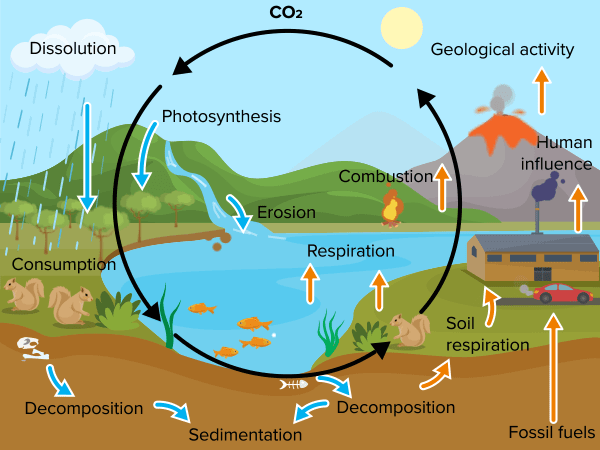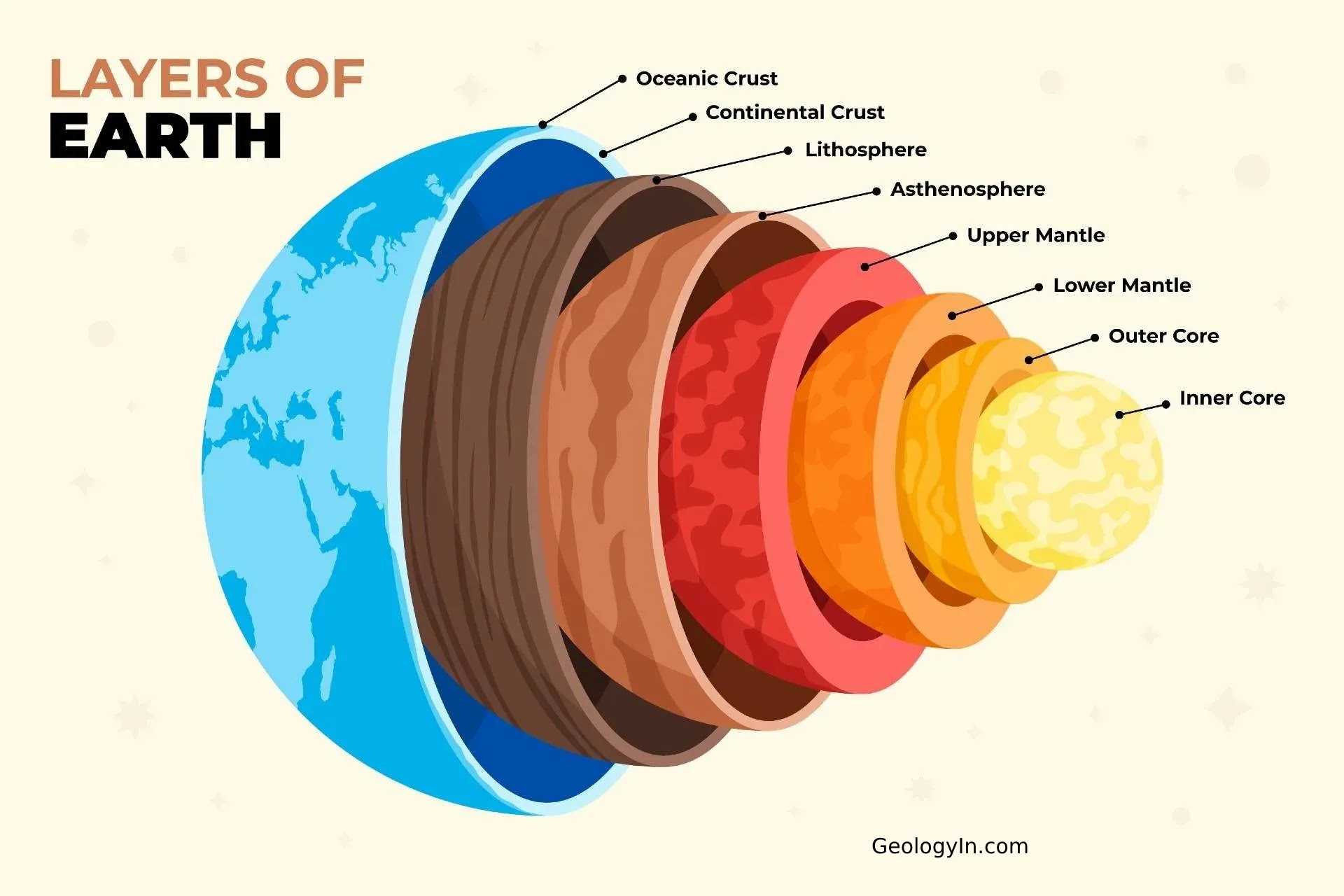Biosphere
The biosphere is a global ecosystem composed of living organisms (biota) and the abiotic (nonliving) factors from which they derive energy and nutrients. The biosphere is a system characterized by the continuous cycling of matter and an accompanying flow of solar energy in which certain large molecules and cells are self-reproducing.
Examples of Cycles

The carbon cycle is the process where carbon compounds are interchanged among the biosphere, geosphere, pedosphere, hydrosphere, and atmosphere of the earth. Carbon is an integral component of every life form on earth. From proteins and lipids to even our DNA. Furthermore, all known life on earth is based on carbon.
Geosphere
The geosphere includes the rocks and minerals on Earth – from the molten rock and heavy metals in the deep interior of the planet to the sand on beaches and peaks of mountains. The geosphere also includes the abiotic (non-living) parts of soils and the skeletons of animals that may become fossilized over geologic time.
Layers

Hydrosphere
The hydrosphere is the collection of every solid and liquid surface waters, groundwater found in the lithosphere, and the atmospheric water vapour.
Sources of Water

About 70% of the Earth is covered with liquid water (hydrosphere) and much of it is in the form of ocean water . Only 3% of Earth's water is fresh. Out of 3%, it is divided into form of ice, stream, lakes, and the ground water.
Atmosphere
The atmosphere is the layer of gases around the Earth, which is held together by the planet's gravity. It is composed of 78% nitrogen, 21% oxygen, and one percent other gases (methane, helium, neon, etc.).
Layers

The outermost layer of Earth’s atmosphere, where air is extremely thin and atoms and molecules can escape into space.

Temperatures are high due to absorption of solar radiation. Aurora lights also occur here.

The coldest layer of the atmosphere. Meteors burn up in this layer.

This layer contains the ozone layer, which absorbs harmful ultraviolet radiation from the Sun

This is the lowest layer, starting from the Earth's surface, where all weather phenomena, like clouds and rain, occurs.











Welcome
SET PAGE ZOOM TO 67%
This is a website based on the old Windows XP and early 2000s websites style used to dedicate information about the Earth's different subsytems!



Click the icons on the top left to navigate

Science Notes- Layers of The Atmosphere
Britannica - Hydrosphere
Britannica - Biosphere
Learning Zone - Geosphere
CK12 - Carbon Cycle
Byjus - Carbon Cycle
Jetstream - Layers of Atmosphere
Learning Zone - Exosphere
Geologyin - Layers of Earth Diagram
Byjus - Nitrogen Cylce
Created by Sean Ka Punta
Contact us: seangabrielleaflores@gmail.com
123-456-789
Crust
Earth's crust is its thick outer shell of rock, comprising less than one percent of the planet's radius and volume. It is the top component of the lithosphere, a solidified division of Earth's layers that includes the crust and the upper part of the mantle.[1] The lithosphere is broken into tectonic plates whose motion allows heat to escape the interior of Earth into space. The crust lies on top of the mantle, a configuration that is stable because the upper mantle is made of peridotite and is therefore significantly denser than the crust. The boundary between the crust and mantle is conventionally placed at the Mohorovičić discontinuity, a boundary defined by a contrast in seismic velocity.
Mantle
The mantle is the mostly solid bulk of Earth’s interior. The mantle lies between Earth’s dense, superheated core and its thin outer layer, the crust. The mantle is about 2,900 kilometers (1,802 miles) thick, and makes up a whopping 84 percent of Earth’s total volume. As Earth began to take shape about 4.5 billion years ago, iron and nickel quickly separated from other rocks and minerals to form the core of the new planet. The molten material that surrounded the core was the early mantle. Over millions of years, the mantle cooled. Water trapped inside minerals erupted with lava, a process called “outgassing.” As more water was outgassed, the mantle solidified. The rocks that make up Earth’s mantle are mostly silicates—a wide variety of compounds that share a silicon and oxygen structure. Common silicates found in the mantle include olivine, garnet, and pyroxene. The other major type of rock found in the mantle is magnesium oxide. Other mantle elements include iron, aluminum, calcium, sodium, and potassium. The temperature of the mantle varies greatly, from 1000°C (1832°F) near its boundary with the crust, to 3700°C (6692°F) near its boundary with the core. In the mantle, heat and pressure generally increase with depth. The geothermal gradient is a measurement of this increase. In most places, the geothermal gradient is about 25°C per kilometer of depth (1°F per 70 feet of depth).
Outer Core
Earth's outer core is a fluid layer about 2,260 km (1,400 mi) thick, composed of mostly iron and nickel that lies above Earth's solid inner core and below its mantle. The outer core begins approximately 2,889 km (1,795 mi) beneath Earth's surface at the core-mantle boundary and ends 5,150 km (3,200 mi) beneath Earth's surface at the inner core boundary. The outer core of Earth is liquid, unlike its inner core, which is solid. Evidence for a fluid outer core includes seismology which shows that seismic shear-waves are not transmitted through the outer core. Although having a composition similar to Earth's solid inner core, the outer core remains liquid as there is not enough pressure to keep it in a solid state. Seismic inversions of body waves and normal modes constrain the radius of the outer core to be 3483 km with an uncertainty of 5 km, while that of the inner core is 1220±10 km.
Inner Core
Earth's inner core is the innermost geologic layer of the planet Earth. It is primarily a solid ball with a radius of about 1,230 km (760 mi), which is about 20% of Earth's radius or 70% of the Moon's radius. There are no samples of the core accessible for direct measurement, as there are for Earth's mantle. The characteristics of the core have been deduced mostly from measurements of seismic waves and Earth's magnetic field. The inner core is believed to be composed of an iron–nickel alloy with some other elements. The temperature at its surface is estimated to be approximately 5,700 K (5,430 °C; 9,800 °F), about the temperature at the surface of the Sun. The inner core is solid at high temperature because of its high pressure, in accordance with the Simon-Glatzel equation.[6]
Exosphere
This is the outermost layer of the atmosphere. It extends from about 375 miles (600 km) to 6,200 miles (10,000 km) above the earth. In this layer, atoms and molecules escape into space and satellites orbit the earth. At the bottom of the exosphere is a transition layer called the thermopause.
The exosphere includes the uppermost region of Earth's atmosphere as it gradually fades into the vacuum of space. The air in the exosphere is extremely thin - in many ways it is almost the same as the airless void of outer space. The exosphere is directly above the thermosphere; the boundary between these two layers is called the thermopause. The bottom of the exosphere is sometimes also referred to as the exobase. The altitude of the lower boundary of the exosphere varies from about 500 to 1000 km (310-620 miles) above the Earth's surface, depending on the amount of incoming X-ray and ultraviolet radiation from the Sun.
Thermosphere
Between about 53 miles (85 km) and 375 miles (600 km) lies the thermosphere, known as the upper atmosphere. While still extremely thin, the gases of the thermosphere become increasingly denser as one descends toward the Earth.
As such, incoming high energy ultraviolet and x-ray radiation from the sun begins to be absorbed by the molecules in this layer and causes a large temperature increase.
However, despite the high temperature, this layer of the atmosphere would still feel very cold to our skin. The high temperature indicates the amount of the energy absorbed by the molecules, but with so few molecules in this layer, the total number would not be enough to heat our skin.
Mesosphere
This layer extends from around 31 miles (50 km) above the Earth's surface to 53 miles (85 km). The gases that comprise this layer continue to become denser as one descends. As such, temperatures increase as one descends, rising to about 5°F (-15°C) near the bottom of this layer.
The gases in the mesosphere are now thick enough to slow down meteors hurtling into the atmosphere, where they burn up, leaving fiery trails in the night sky. Both the stratosphere (next layer down) and the mesosphere are considered the middle atmosphere. The transition boundary which separates the mesosphere from the stratosphere is called the stratopause.
Stratosphere
The stratosphere extends from 4 -12 miles (6-20 km) above the Earth's surface to around 31 miles (50 km). This layer holds 19 percent of the atmosphere's gases but very little water vapor.
In this region, the temperature increases with height. Heat is produced in the process of the formation of ozone, and this heat is responsible for temperature increases, from an average -60°F (-51°C) at tropopause to a maximum of about 5°F (-15°C) at the top of the stratosphere.
This increase in temperature with height means warmer air is located above cooler air. This prevents convection as there is no upward vertical movement of the gases. As such, the location of the bottom of this layer is readily seen by the anvil-shaped tops of cumulonimbus clouds
The transition layer at the bottom of the stratosphere is called the tropopause.
Troposphere
Known as the lower atmosphere, almost all weather occurs in this region. The troposphere begins at the Earth's surface, but the height of the troposphere varies. It is 11-12 miles (18-20 km) high at the equator, 5½ miles (9 km) at 50°N and 50°S, and just under four miles (6 km) high at the poles.
As the density of the gases in this layer decrease with height, the air becomes thinner. Therefore, the temperature in the troposphere also decreases with height. As one climbs higher, the temperature drops from an average around 62°F (17°C) to -60°F (-51°C) at the tropopause.